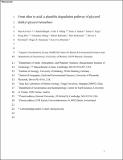From ether to acid: A plausible degradation pathway of glycerol dialkyl glycerol tetraethers
Author(s)
Birgel, Daniel; Elling, Felix J.; Sutton, Paul A.; Lipp, Julius S.; Zhu, Rong; Zhang, Chuanlun; Könneke, Martin; Peckmann, Jörn; Rowland, Steven J.; Hinrichs, Kai-Uwe; Liu, Xiaolei; Summons, Roger E; ... Show more Show less
DownloadSummons_From ether to acid.pdf (6.757Mb)
PUBLISHER_CC
Publisher with Creative Commons License
Creative Commons Attribution
Terms of use
Metadata
Show full item recordAbstract
Glycerol dialkyl glycerol tetraethers (GDGTs) are ubiquitous microbial lipids with extensive demonstrated and potential roles as paleoenvironmental proxies. Despite the great attention they receive, comparatively little is known regarding their diagenetic fate. Putative degradation products of GDGTs, identified as hydroxyl and carboxyl derivatives, were detected in lipid extracts of marine sediment, seep carbonate, hot spring sediment and cells of the marine thaumarchaeon Nitrosopumilus maritimus. The distribution of GDGT degradation products in environmental samples suggests that both biotic and abiotic processes act as sinks for GDGTs. More than a hundred newly recognized degradation products afford a view of the stepwise degradation of GDGT via (1) ether bond hydrolysis yielding hydroxyl isoprenoids, namely, GDGTol (glycerol dialkyl glycerol triether alcohol), GMGD (glycerol monobiphytanyl glycerol diether), GDD (glycerol dibiphytanol diether), GMM (glycerol monobiphytanol monoether) and bpdiol (biphytanic diol); (2) oxidation of isoprenoidal alcohols into corresponding carboxyl derivatives and (3) chain shortening to yield C39and smaller isoprenoids. This plausible GDGT degradation pathway from glycerol ethers to isoprenoidal fatty acids provides the link to commonly detected head-to-head linked long chain isoprenoidal hydrocarbons in petroleum and sediment samples. The problematic C80to C82tetraacids that cause naphthenate deposits in some oil production facilities can be generated from H-shaped glycerol monoalkyl glycerol tetraethers (GMGTs) following the same process, as indicated by the distribution of related derivatives in hydrothermally influenced sediments.
Date issued
2016-06Department
Massachusetts Institute of Technology. Department of Earth, Atmospheric, and Planetary SciencesJournal
Geochimica et Cosmochimica Acta
Publisher
Elsevier BV
Citation
Liu, Xiao-Lei, et al. “From Ether to Acid: A Plausible Degradation Pathway of Glycerol Dialkyl Glycerol Tetraethers.” Geochimica et Cosmochimica Acta, vol. 183, June 2016, pp. 138–52. © 2016 Elsevier Ltd.
Version: Author's final manuscript
ISSN
0016-7037